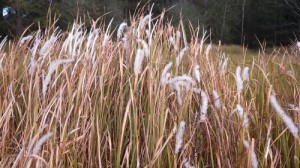We’re waging war on an invasive weed, Cogongrass. Cogongrass was accidently brought into Mobile, Alabama in the early 1900’s as packing material. It was later planted in Florida and other states as a potential forage and soil stabilizer. It has low forage value and is on the Federal Noxious Weed List.
This weed can spread through both creeping rhizomes and seeds. It quickly displaces desirable grasses and plants. The roots of Cogongrass may produce allelopathic chemicals helping it out-compete other plants for space. It is drought and shade tolerant. A single plant can produce 3,000 seeds. Cogongrass is yellow/green in color with an off-set midrib and a fluffy white seed head and it grows in circular colonies.
Mowing and burning will not eradicate Cogongrass instead doing so while the plants are flowering can cause spread of seeds. Herbicide options are non-selective and kill most native ground cover such as grasses. Ridding an area of a Cogongrass infestation requires intensive management. For small infestations (less than 20-30 feet in diameter), treat the area with glyphosate once in the fall and once in the spring for 3 years (or until eradicated). For larger infestations, a more integrated approach may be necessary. Deep tilling of the soil may help in some cases.
Cogongrass is not easy to control. It takes a coordinated effort from government agencies and private landowners to work together to rid an area of this invasive weed. For more information, you can go to https://edis.ifas.ufl.edu/wg202 or contact your local extension agent.
- Killer Turkey Food Plot - January 31, 2025
- Common Wildlife Food Plot Mistakes - November 8, 2024
- Seasonality of Prescribed Burning Workshop - February 23, 2024

